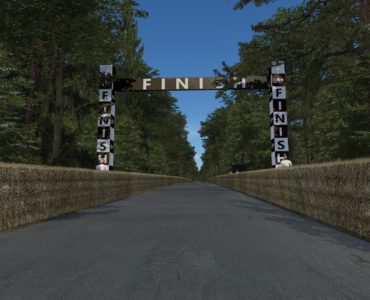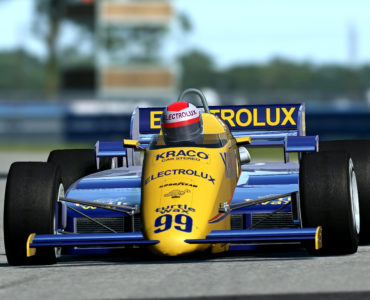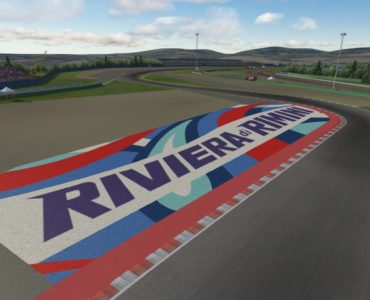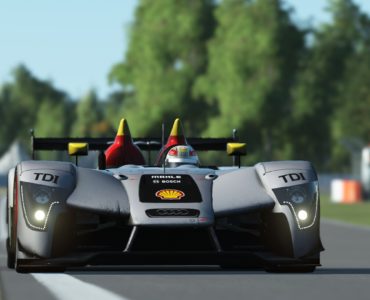Team 21 has brought plenty of great add-on cars to GT Legends and here’s the newest as the team has released the Maserati 450S for Simbin’s historical racing simulation.
Instead of showing off lots of development previews, the team has released their newest car in a surprise move, treating the GTL community to another masterpiece.
The car comes with scratch-made physics, sounds & graphics, a template to paint up your own liveries is included as well!
[toggle title=”Click here for the full read me”] Projected and made in a virtual garden for automotive dreams. We arevery happy to present our newest creation! The mighty Maserati 450S.
Installation:
Copy the unpacked data into your GT Legends install which contains the GameData folder.
No responsibility for user errors.
A template for the painters to use will be provided. If you repect
Maseratis and the cars history, please refrain from painting modern
style liveries.
Please ask us for permission if you plan alterations of its files at GTR4u.de. No upload to other sites allowed.
Please respect our hard work.
Thanks und Credits:
Cooky: 3D Modell, ZMod, 3DSimED, PS, templates, textures
Citytea: Sound design, PS, templates, textures
Mental Gear: Physics, technical and historic research, physics testing, PS, textures
Nowsit down on your driving chair, imagine yourself back to 1957 where
oil drenched drivers and even spectators often died when they had a
crash and rekindle the manliness in you.
Big thanks goes to all our team members for the great cooperation and personal dedication
Mental Gear
Car History:
The woodland creatures scurry, bolt and scramble, for the ‘Bazooka’,
though still some way distant, is most definitely within earshot. This
is not a car for the shy or sensitive, timid or tremulous. Vlad the
Impaler would have loved it, though. Maserati’s Tipo 54, that’s Mister
450S to you and me, sounds like thunder and goes like the clappers???It’s
big, beautiful and brutal. MotorSport magazine, January 2005.
Few sports-racing cars carry a fearsome reputation to equal Maserati’s
thunderous Tipo 54, better known as the 450S. Originally conceived in
1954 to challenge Ferrari’s ‘big banger’ sports racers, the Tipo 54
project was bankrolled by South Californian cement and construction
baron, team boss and partygoer Tony Parravano. Eager to win the
Indianapolis 500, Parravano had ordered two 4.2 V8 engines and intended
to put them into Kurtis chassis. Nothing came of this project, so
instead Maserati developed a sports racing car around the engine which
was intended to challenge Ferrari in the World Sports Car Championship.
The new V8, by now enlarged to 4488cc, “almost shook the factory walls
down as it registered 400bhp on the dyno. The years of Ferrari
outmuscling Maserati were definitely over.” recalled MotorSport.
The determination, with whom, during the fifties, the Maserati factory
dealt with Sport cars Championship, lead to the building of many cars
more and more powerful. The last stage of this escalation was the
monstrous 450 Sport. Its story started in 1954 with a new project called
“Tipo 54”. Maybe Gioachino Colombo, more than one year before, was the
first to have such idea, but several factors forced to abandon the
project for some time: the terrible accident of 1955’s Le Mans race, the
lack of an ascendant from which it would have been possible to take
inspiration. As for the Maserati 250F, the realisation of the project
was entrusted to those members of the staff, directed by engineer
Alfieri, who were specialised in every part of the car: Guido Taddeucci
projected the engine, Valerio Colotti chassis and transmission.
Maybe the most difficult task was Colotti’s one that was a complex DOHC 8
cylinders, 90?? V. Nevertheless he was helped by the experience of the 4
cylinders engines of the 150S and 200S : the carburettors were
installed in the middle of the “V”. Two magnets, posed in front of the
engine, secured the sixteen candles working. Now, where Taddeucci’s work
finished, started Colotti’s task: he had to project a transmission that
was able to discharge almost 400 hp on the ground. He projected a big
5-speed transaxle which were posed inside the wheel-base. The big clutch
had four steel rings and five aluminium rings. At the exit there were
two cylindrical gears which permitted to change gears. The chassis was
clearly re-engaged from the 300S: oval tubes with big section formed the
base and it was integrated with an upper structure formed by circular
tubes. The same scheme was adopted for anterior suspensions, whereas the
rear axle with De Dion tube was drawn again: The tube passed behind the
differential housing.The 450S received a completely new brake-system:
there were enormous drum-brakes (40 cm in diameter in the opposite, 35
cm in the rear).
The first engine was assembled, in August 1956, on the chassis n??3501
that was used by Stirling Moss during the 1956 Mille Miglia race. After a
brief test, it was taken to Sweden, and on August 7th, it participated
in Sweden grand prix. The new car was recognised for the big hump on the
anterior bonnet which hid the carburettors, and for the four exhaust
pipes which appeared in the side (but they substituted because they
caused great problems in reliability. In particular, there was great
worry for the engine, which caused great vibrations, which stretched to
the transmission. This problem was solved during the next autumn, when
ignition order was revised. The 450S was ready to face the 1957
championship, but its birth was overdrawn and over budget. The R&D
cost of $ 400.000-500.000 was colossal by the standards of the era. The
n??4501, with a new chassis and body, made its debut in Buenos Aires
race. It revealed a great handling but it failed its success for youth’s
problems. But at Sebring race, the n??4503, driven by Fangio and Behra,
won with great facility.
In the meanwhile, in Modena, the evolution of the model went on, and by
n??4504 a new ignition-system with two coil ignitions, double shock
absorbers, new oil tanks were adopted. On the n??4505 an additional
two-speed gearbox was assembled between the engine and the transmission:
in practice it acted as an overdrive which permitted to pull down the
revolutions number. It was adopted also on n??4507, n??4508, and n??4501
for LeMans race, which represented the most important objective for
Maserati. 1957 LeMans and N??rburgring races were lost, but Maserati was
still in race for championship winning, which after Sweden Grand Prix
success, thanks to Fangio and Behra, was really within reach. Most of
all the 450S suffered for guidability problems: the enormous power (430
hp at the end of 1957) requested great sensibility in acceleration
distributing. However great handling qualities, invited to pull down
one’s foot, as much as this excess of confidence that the car gave,
caused many problems.
As the backer behind its development, though, Parravano was destined to
receive the first ‘production’ example, chassis ‘4502’, which had been
shipped to him at the end of 1956. Thankfully ‘4502’ avoided the
Venezuelan carnage, stashed away near the Mexican border, supposedly out
of reach of the Inland Revenue Service.
Tony ran a construction empire in Southern California and had trouble
maintaining proper books pertaining to his businesses. As a result
virtually no corporate taxes were paid until the Internal Revenue
Service caught up with him. Tony fled to Mexico in June, 1957, and the
IRS people settled Parravano’s tax liabilities in January, 1959, by
auctioning off his extensive collection of Italian exotics, at least
that part not siphoned off to Mexico previously. One of the auctioned
cars was the 450S, chassis 4502. Willem Oosthoek, The Maserati Club
magazine.
The outcome of the 1957 World Sports Car Championship depended on the
final Venezuelan 1,000km in Caracas on November 3. Two works 450S cars –
’03’ and ’07’ – were supported there by a special 4.7-litre customer
car ‘4508’ freshly-delivered to American entrant Temple Buell. Sterling
Moss/Jean Behra/Schell were to handle the works cars, Masten
Gregory/Dale Duncan would drive Buell’s. Maserati ran a 300S for Jo
Bonnier as insurance but the race became a famous Maserati disaster.
On only the second lap, Gregory flipped Buell’s car. Moss led until lap
33 when a slow back marker wandered into his path, demolishing ‘4503’s
front end. Its sister ‘4507’, then ignited during a pit stop, burning
Behra, after which Moss and Schell took over in an attempt to fight back
against Ferrari. Incredibly, Bonnier’s 300S then lost a front wheel
just as it was being overtaken by Schell in the already charred 450S.
Both cars crashed heavily; Schell’s big V8 burning out while Bonnier’s
300S demolished itself against a streetlamp.
So four front-line Maseratis had started this Championship deciding
race, and all had crashed – leaving the World Championship title to
Ferrari.
Perhaps unnerved by the big Maser’s gargantuan performance (and that of
Ferrari’s 4 litre V12s) the powers-that-be implemented a 3 litre sports
car formula from 1958, and the car’s European career was over. The 450S
were forced to immigrate to USA where it dominated races with Carrol
Shelby, Eb Rose, Masten Gregory, Jim Hall, and Walt Cline. This enormous
success was due to some disinterested benefactors: Tony Parravano,
Temple Buell, Masten Gregory.From 1959 started 450 S’s career, with its
sea version. The first engine that was developed, was type 59 with 5665
displacement (bore x stroke: 103×85), which gave 520 hp. In 1962 came
three new versions: type 201 (5400 cc, 420 hp), type 62 (6462 cc, 580
hp), type 202 (4941 cc, 330 hp). These engines were assembled on race
boats, which won many European and world championships during the
sixties with Lino Spagnoli, Flavio Guidotti, Liborio Guidotti, Giorgio
Guidotti, Nando dell’Orto, Ermanno Marchisio and Luigi Crivelli.
This awe-inspiring beast encapsulates all the spirit and majesty and
disappointed failure that made Maserati the great marque it was. There
are not very many racing cars of which we can say ‘When it didn’t break
it won’.
The Maserati 450S was the most powerful front engine prototype-sportscar
for about 40 years until Panoz came along with it’s sports prototypes
in the late 1990s.
[/toggle]
Built from 1956 to 1958, nine 450S were built by Maserati for competition in the World Sports Car Championship. Powered by 4.2 liter V8 engines, the cars were driven by notable drivers such as Juan Manuel Fango & Stirling Moss, facing competition from Ferrari, Jaguar and others at iconic events like the Mille Miglia and the 12 Hours of Sebring.
[boxdownload]Download??Maserati 450S for GT Legends Here[/boxdownload]












